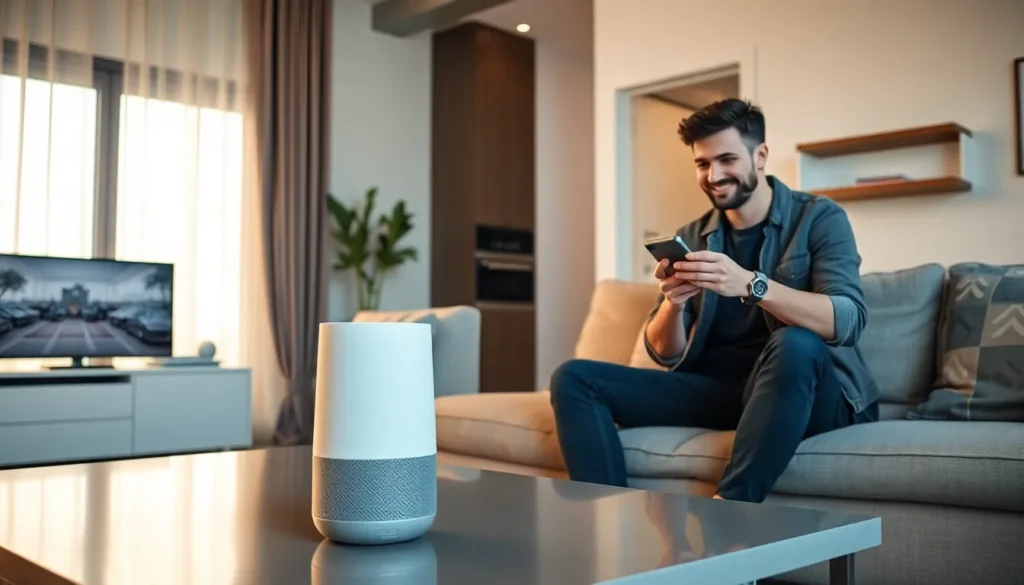In a world where digital clutter reigns supreme, minimalist web design emerges like a breath of fresh air. Picture this: websites that load faster than a caffeinated squirrel, with clean lines and a focus on what truly matters. It’s not just about looks; it’s about creating an experience that’s as smooth as butter on warm toast.
Minimalist Web Design
Minimalist web design emphasizes simplicity and functionality. This approach strips away unnecessary elements, allowing essential content to take center stage. Users experience faster loading times due to reduced graphic and script usage, making navigation seamless.
Focus remains on clean lines and open spaces, creating an uncluttered interface. Visual hierarchy directs users to key messages and calls to action. By prioritizing usability, designers enhance user engagement, fostering a more pleasant browsing experience.
Effective color schemes and typography play crucial roles in minimalist designs. A limited color palette prevents overwhelming users, while careful selection of fonts improves readability. Icons and images, when used, serve clear purposes and support overall clarity.
Every element in a minimalist design must contribute to the end goal. Each component, whether a button or text box, carries significance. Redundant features often distract from the primary message; therefore, thoughtful curation of elements proves essential.
Minimalism also aligns well with responsive web design principles. As more users access websites via mobile devices, functionality and readability become paramount. Websites that prioritize minimalistic design ensure compatibility across various screen sizes.
Minimalist web design fosters a user-centered experience. It encourages designers to think critically about what elements truly add value. This intentional approach not only enhances aesthetic appeal but also improves overall performance.
Key Principles of Minimalist Web Design

Minimalist web design centers on several key principles that enhance user experience. Designers prioritize simplicity, functionality, and usability to create effective websites.
Simplicity
Simplicity in design emphasizes the importance of essential elements. Stripping away unnecessary components focuses users on core content. Clean layouts allow for easy navigation, guiding visitors to important information without distractions. Minimalistic visuals, such as ample white space, provide breathing room. This practice fosters a sense of calm, making content easier to digest. Additionally, a restrained color palette avoids overwhelming users, ensuring that attention remains where it matters. Each design choice contributes directly to a streamlined user journey.
Functionality
Functionality remains a cornerstone of minimalist web design. Websites must operate efficiently to ensure optimal user engagement. Designers focus on intuitive interfaces, enabling visitors to complete tasks quickly. Fast loading times minimize frustration while promoting higher retention rates. Essential features, like clear calls to action, drive user interaction and improve conversion rates. Purposeful design decisions eliminate redundant functions, ensuring that every element serves a specific goal. Ultimately, an emphasis on functionality transforms the online experience.
Usability
Usability plays a vital role in minimalist design. Websites should cater to diverse user needs, promoting accessibility and satisfaction. Designers often employ responsive layouts, ensuring seamless functionality across devices. Mobile-friendliness enhances usability, appealing to the growing number of mobile users. Clear navigation bars simplify access to different sections, allowing easy exploration. Feedback mechanisms, like hover effects or loading indicators, improve user interaction by providing necessary response cues. Prioritizing usability leads to a more engaging and effective web presence.
Benefits of Minimalist Web Design
Minimalist web design offers numerous advantages that contribute to overall site performance and user satisfaction. Two key benefits include enhanced user experience and improved load times.
Enhanced User Experience
An uncluttered interface helps users find essential information quickly. Clear focus on core content directs user attention without unnecessary distractions. Streamlined navigation enhances engagement, allowing visitors to accomplish tasks effectively. The simplified layout fosters a sense of calm, improving overall satisfaction. Designers prioritize critical elements, ensuring that users interact with the most relevant content. Each choice made in minimalist design enhances usability, creating a pleasant browsing experience.
Improved Load Times
Fast loading times significantly impact user retention rates. Minimalist web design reduces the number of elements on a page, which speeds up load times considerably. A lean approach to images and scripts optimizes performance, encouraging users to stay longer. Search engines factor in page speed, meaning faster sites often rank higher in search results. Each millisecond counts, and streamlined designs enhance overall efficiency, resulting in improved site performance. Focusing on essential content allows designers to ensure that users experience minimal delays.
Examples of Effective Minimalist Web Design
Minimalist web design shines through various examples that showcase its principles. Noteworthy sites demonstrate effective use of simplicity and functionality.
Case Study: Popular Minimalist Websites
Apple’s website exemplifies minimalist design with a clean layout. Its focus on product imagery and succinct text highlights featured products while eliminating distractions. Similarly, Dropbox utilizes a straightforward interface, emphasizing user functionality and easy navigation, enhancing user engagement. A third example is the website for Squarespace, where ample white space complements striking visuals and clear calls to action, effortlessly guiding users. These sites illustrate the power of minimalism in creating visually appealing and highly functional online experiences.
Design Techniques in Action
Effective minimalist designs employ several techniques to maximize impact. Designers use a limited color palette to maintain visual harmony and make content more digestible. Choosing typography carefully enhances readability without overwhelming users. Moreover, whitespace is strategically employed to separate elements, allowing focus on essential content. Visual hierarchy directs attention, ensuring users understand the importance of various messages. Lastly, responsive layouts adapt seamlessly across devices, guaranteeing usability on smartphones and tablets. Through these techniques, minimalist design creates a user-focused experience that prioritizes functionality and aesthetic appeal.
Challenges of Minimalist Web Design
Minimalist web design presents unique challenges that developers must navigate. Striking a balance between simplicity and functionality often proves difficult. Designers might struggle to convey messages effectively, as removing elements can lead to ambiguous interpretations. A lack of resources may result in inadequate visual cues, leaving users confused about navigation.
Cost implications arise with minimalist design. Creating custom graphics or ensuring high-quality typography incurs expenses. Limited design elements might require more effort in achieving visual appeal, leading to potentially higher costs. Additionally, achieving responsiveness across various devices demands thorough testing to maintain functionality, which can add to the project timeline.
User expectations also impose challenges. Visitors often expect rich media and engaging visuals. When a website features minimal elements, users might perceive it as underwhelming. Addressing this perception remains essential for maintaining user interest and satisfaction. Designers must then innovate to deliver an engaging experience without overwhelming users.
SEO considerations factor significantly into minimalist design. While clean layouts enhance user experience, they may lack the content density that search engines value. Ensuring that essential keywords and phrases are effectively integrated without cluttering the design requires careful planning and strategic placement.
Maintaining brand identity can be problematic as well. Stripped-down visuals might dilute a brand’s uniqueness or message. Utilizing a cohesive color palette and appropriate typography addresses branding concerns, but achieving this within minimalist constraints poses a creative challenge.
Minimalist web design embodies distinct challenges including clarity in messaging, cost considerations, user expectations, SEO optimization, and brand identity maintenance that designers must address to create successful user-centered experiences.
Conclusion
Minimalist web design stands out as a powerful approach in today’s digital landscape. By prioritizing essential elements and focusing on user experience it creates an environment where visitors can easily navigate and engage with content. The strategic use of whitespace clean lines and effective typography enhances both aesthetics and functionality.
While challenges exist in maintaining brand identity and meeting user expectations a well-executed minimalist design can significantly improve site performance and user satisfaction. As more users turn to mobile devices the importance of responsive minimalist layouts becomes even clearer. Embracing this design philosophy not only simplifies the browsing experience but also positions brands for success in an increasingly cluttered online world.

